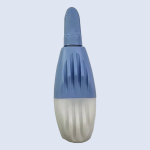Technical Summary
| Profile Summary | |
|---|---|
| Optimum Collection Volume: | 3 Spots |
| Methodology: | ECL |
| Assay Range(s) | |
|---|---|
| 3-Plex: | |
| IL-6: | 0.80–3280 pg/mL |
| IL-10: | 0.37–1512 pg/mL |
| TNF-alpha: | 0.35–1452 pg/mL |
| Technical Documentation |
|---|
| Assay Sensitivity | |
|---|---|
| 3-Plex: | |
| IL-6: | 0.80 pg/mL |
| IL-10: | 0.37 pg/mL |
| TNF-alpha: | 0.35 pg/mL |

How to collect DBS Cytokine Panel 3-plex (IL-6, IL-10, TNF-alpha)
APPROVED DRIED BLOOD SPOT COLLECTION METHODS
Analyte Summary
3-Plex Cytokine Panel
IL-6
Human Interleukin-6 (IL-6) is a 23.7 kDa cytokine primarily secreted by T cells and macrophages and is also released from muscle cells during exercise. In Dried Blood Spot samples, IL-6 serves as a reliable marker of systemic inflammation, acute phase responses, and immune activation. IL-6 measured from Dried Blood Spots correlates strongly with plasma levels, making it suitable for remote, field, or population-based studies where venipuncture is impractical. Dysregulated IL-6 signaling has been implicated in osteoporosis, pulmonary fibrosis, liver disease, ischemia, autoimmune conditions, and metabolic disorders, and elevated IL-6 in DBS reflects chronic inflammatory states and cardiovascular risk.
IL-10
Human Interleukin-10 (IL-10) is mainly produced by monocytes and some lymphocytes and is an anti-inflammatory cytokine that inhibits the synthesis of numerous cytokines (including IFN-γ, IL-2, IL-3, TNF-α, TNF-β, and GM-CSF) that plays a key regulatory role in suppressing excessive immune responses and mitigating tissue damage. It counteracts the effects of pro-inflammatory cytokines like IL-6 and TNF-α, making it an important marker for immune regulation and homeostasis in chronic inflammatory conditions.
TNF-Alpha
Human Tumor Necrosis Factor Alpha (TNF-α) is a potent proinflammatory cytokine that induces the classic signs of inflammation to occur locally and is one of the cytokines that make up the acute phase reaction. TNF-α is mainly produced by activated macrophages as a 25.6 kDa protein that forms a noncovalent homotrimer, but can also be secreted by a variety of cells. Large amounts of TNF-α are released in response to lipopolysaccharide and other bacterial components and interleukin-1. It is a potent chemoattractant for neutrophils. It also stimulates IL-1, which induces cachexia and causes fever. It can also induce sepsis and inflammation and can inhibit tumorigenesis and viral replication. Chronic TNF-α dysregulation has been associated with autoimmune diseases such as rheumatoid arthritis and inflammatory bowel disease as well as psoriasis and asthma. TNF-α can be inhibited by the exercise induced myokines such as IL-6 and IL-10. While essential for host defense, chronic TNF-α dysregulation contributes to autoimmune disorders including rheumatoid arthritis, inflammatory bowel disease, psoriasis, and asthma. Elevated systemic TNF-α is also associated with metabolic syndrome and chronic stress-related pathology.
References & DBS Cytokine Research
-
- McDade, T. W., Burhop, J., & Dohnal, J. (2004). High-sensitivity enzyme immunoassay for C-reactive protein in dried blood spots. Clinical Chemistry, 50(3), 652–654. https://doi.org/10.1373/clinchem.2003.029488
- McDade, T. W., Williams, S., & Snodgrass, J. J. (2007). What a drop can do: Dried blood spots as a minimally invasive method for integrating biomarkers into population-based research. Demography, 44(4), 899–925. https://doi.org/10.1353/dem.2007.0038
- McDade, T. W., Borja, J. B., Kuzawa, C. W., Perez, T. L., & Adair, L. S. (2012). C-reactive protein response to influenza vaccination as a model of mild inflammatory stimulation in the Philippines. Vaccine, 30(2), 389–393. https://doi.org/10.1016/j.vaccine.2011.10.081
- McDade, T. W., Sherwood, J. W., & D’Aquila, R. T. (2016). Use of dried blood spots for measuring cytokines and other biomarkers of inflammation. Annals of the New York Academy of Sciences, 1377(1), 96–105. https://doi.org/10.1111/nyas.13162
- McDade, T. W., et al. (2020). Validation of dried blood spot assays for inflammatory cytokines (IL-6, IL-8, IL-10, TNF-α) using a multiplex immunoassay platform. American Journal of Human Biology, 32(4), e23558. https://doi.org/10.1002/ajhb.23558
- Crimmins, E. M., et al. (2014). Documentation of biomarkers in the Health and Retirement Study. University of Michigan, Survey Research Center. Retrieved from https://hrs.isr.umich.edu/sites/default/files/biblio/Documentation_Inflammation_Biomarkers.pdf
- O’Bryant, S. E., et al. (2014). Validation of dried blood spot for cytokine assays: A pilot study. Clinical Chemistry and Laboratory Medicine, 52(5), 701–708. https://doi.org/10.1515/cclm-2013-0944
- Eisenberg, D. T. A., Kuzawa, C. W., & Hayes, M. G. (2017). Dried blood spot collection for measurement of inflammatory markers in population-based research. American Journal of Human Biology, 29(4), e22943. https://doi.org/10.1002/ajhb.22943
- Skogstrand, K., Thorsen, P., Nørgaard-Pedersen, B., Schendel, D. E., Sørensen, L. C., & Hougaard, D. M. (2005). Simultaneous measurement of 25 inflammatory markers and neurotrophins in neonatal dried blood spots by immunoassay with xMAP technology. Clinical Chemistry, 51(10), 1854–1866. https://doi.org/10.1373/clinchem.2005.052241
- Zajacova, A., Montez, J. K., & Herd, P. (2014). Socioeconomic disparities in health: An examination of biomarkers in the Health and Retirement Study. Journals of Gerontology: Social Sciences, 69(7), 884–896. https://doi.org/10.1093/geronb/gbu005
- Turner MD, Nedjai B, Hurst T, Pennington DJ. (2014). Cytokines and chemokines: At the crossroads of cell signalling and inflammatory disease. Biochim Biophys Acta, 1843(11), 2563–2582.
- Kak G, Raza M, Tiwari BK. (2018). Interferon-gamma (IFN-gamma): Exploring its implications in infectious diseases. Biomol Concepts, 9(1), 64–79.
- Ivashkiv LB. (2018). IFNgamma: signalling, epigenetics and roles in immunity, metabolism, disease and cancer immunotherapy. Nat Rev Immunol, 18(9), 545–558.
- MacLean E, Broger T, Yerlikaya S, Fernandez-Carballo BL, Pai M, Denkinger CM. (2019). A systematic review of biomarkers to detect active tuberculosis. Nat Microbiol, 4(5), 748–758.
- Zundler S, Neurath MF. (2015). Interleukin-12: Functional activities and implications for disease. Cytokine Growth Factor Rev, 26(5), 559–568.
- Teng MW, Bowman EP, McElwee JJ, Smyth MJ, Casanova JL, Cooper AM, et al. (2015). IL-12 and IL-23 cytokines: from discovery to targeted therapies for immune-mediated inflammatory diseases. Nat Med, 21(7), 719–729.
- Tait Wojno ED, Hunter CA, Stumhofer JS. (2019). The Immunobiology of the Interleukin-12 Family: Room for Discovery. Immunity, 50(4), 851–870.
- Ingram JL, Kraft M. (2012). IL-13 in asthma and allergic disease: asthma phenotypes and targeted therapies. J Allergy Clin Immunol, 130(4), 829–842; quiz 843–844.
- Mao YM, Zhao CN, Leng J, Leng RX, Ye DQ, Zheng SG, et al. (2019). Interleukin-13: A promising therapeutic target for autoimmune disease. Cytokine Growth Factor Rev, 45, 9–23.
- McGeachy MJ, Cua DJ, Gaffen SL. (2019). The IL-17 Family of Cytokines in Health and Disease. Immunity, 50(4), 892–906.
- Veldhoen M. (2017). Interleukin 17 is a chief orchestrator of immunity. Nat Immunol, 18(6), 612–621.
- Lubberts E. (2015). The IL-23-IL-17 axis in inflammatory arthritis. Nat Rev Rheumatol, 11(10), 562–572.
- Geremia A, Jewell DP. (2012). The IL-23/IL-17 pathway in inflammatory bowel disease. Expert Rev Gastroenterol Hepatol, 6(2), 223–237.
- Brembilla NC, Senra L, Boehncke WH. (2018). The IL-17 Family of Cytokines in Psoriasis: IL-17A and Beyond. Front Immunol, 9, 1682.
- Mease P, McInnes IB. (2016). Secukinumab: A New Treatment Option for Psoriatic Arthritis. Rheumatol Ther, 3(1), 5.
- Dubucquoi S, Desreumaux P, Janin A, Klein O, Goldman M, Tavernier J, et al. (1994). Interleukin 5 synthesis by eosinophils: association with granules and immunoglobulin-dependent secretion. J Exp Med, 179(2), 703–708.
- Yanagibashi T, Satoh M, Nagai Y, Koike M, Takatsu K. (2017). Allergic diseases: From bench to clinic – Contribution of the discovery of interleukin-5. Cytokine, 98, 59–70.
- Narendra DK, Hanania NA. (2019). Targeting IL-5 in COPD. Int J Chron Obstruct Pulmon Dis, 14, 1045–1051.
- Busse W, Chupp G, Nagase H, Albers FC, Doyle S, Shen Q, et al. (2019). Anti-IL-5 treatments in patients with severe asthma by blood eosinophil thresholds: Indirect treatment comparison. J Allergy Clin Immunol, 143(1), 190–200.e20.
- Ballou SP, Lozanski G. (1992). Induction of inflammatory cytokine release from cultured human monocytes by C-reactive protein. Cytokine, 4(5), 361–368.
- Barata JT, Durum SK, Seddon B. (2019). Flip the coin: IL-7 and IL-7R in health and disease. Nat Immunol, 20(12), 1584–1593.
 Contact: Salimetrics (USA)
Contact: Salimetrics (USA)
